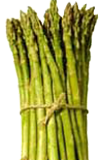 |
Asparagus

back to foods
|
BENEFICIAL During
asparagus season, I often notice that my urinary pH registers acid,
a pH of 5.5. The reason for this is that asparagus is such a potent
alkalizer, eliminating much of the old residual acids, that is the one
time I experience acidic pH joyfully because I know it is ridding my
body of stored acids and converting them to a cleansed alkaline. This
will happen even if I take special care to drink extra fluid. A few
drops of nettle extract in a cup of hot water will hasten this process
converting my urinary pH to alkaline. With
the first new growth of spring. I often pluck off a piece of asparagus
eating it raw straight from the garden.- deliciously sweet.
The
formation of uric acid crystals are linked to the kidneys. A safe kidney
flush and spleen booster is to have a bowl of fresh asparagus. Because
of the ability of asparagus to provide this flush effect, for many years
asparagus was believed to be acid producing. It is now known that this
seemingly production of acids is caused from the cleansing properties
and that asparagus has indeed a super beneficial alkaline effect.
In
Germany when white asparagus is in season it is the star offering on
restaurant menus all of the country. Ordering an entire meal of tasty
white asparagus, diners happily eat a pound or more at one sitting.
An added plus is that asparagus lowers uric acid, known to be high in
Polycystic Kidney Disease. Nettles also lowers uric acid
Asparagus is alkaline producing though it will make the urine acidic. When eating asparagus, I often notice that my urinary pH
registers acid, a pH of 5.5. Asparagus is high in phosphorus and
potassium. Oftentimes I would snap off a stalk on my morning walks, nibbling the sweet tidbit.
|
For a long
time asparagus was thought of as an acidic vegetable. Kindly make a note,
my urinary pH does drop to about 5.5 while eating asparagus. This
happens consistently even when I dutifully drink 2-3 liters of water
daily. This comes about by asparagus releasing long standing old acids
from within the system. This is a case when urinary acidity is good
thing. Asparagus is such a potent alkalizer, eliminating much of the old
residual acids, that it is one time when I experience a urinary acid pH
joyfully because I know it is riding my body of old stored toxins and
converting them to a cleansed alkaline state. My urinary pH will
consistently correct itself and come right around to 6.5, 7.0, 7.5 once
asparagus season has stopped. A few drops of nettle extract in a cup of
hot water will hasten this process converting my urinary pH immediately
to alkaline. Nettle is high in potassium. If you have a history of kidney stones, you may want to consumeonly small quantities as asparagus has some low oxalates. Asparagus also contains purine compounds that promote gout and can elevate uric acid levels. However an old study concluded that eating asparagus had no effect on future kidney stone formation.
What is the growing season for asparagus? In Michigan, asparagus is harvested for a six - seven week period from
late April or early May through mid to late June.
Why does my urine smell funny after consuming asparagus? Most authorities feel that the compound that causes the odor in urine
after consumption of asparagus is methylmercaptan, which is a
sulfur-containing derivative of the amino acid, methionine. This is
disputed by a few individuals who claim that the odiferous compound is
asparagine-amino-succinic-acid monoamide, which is derived from the
amino acid, asparagine. In either case, the product is formed as a
derivative during the digestion and subsequent breakdown of beneficial
amino acids that occur naturally in asparagus.
Ref: Merck Index, 862; Food Chemistry, Belitz and Grosch, pg. 271.
What are the nutritional benefits of asparagus? A 5.3 ounce serving (approximately 5 spears) has only 20 calories, 0
fat or cholesterol, 5 milligrams of sodium, 400 milligrams of potassium,
3 grams of fiber, 60% of the USRDA of folacin, and are excellent sources
of thiamin and vitamin B6.
Where does asparagus grow? Asparagus grows best in sandy, well-drained soil. In Michigan, most of
the commercial acreage is on the west-central part of the state around
Hart and Shelby in Oceana County, near Lake Michigan. Only the states of
California and Washington produce more asparagus than Michigan.
What do I do with the fern growth after I am done harvesting asparagus? Do not cut it down until the fall when it has turned all brown. The
fern is what feeds the crown nutrients so that it will produce spears
again in the spring.
Is there some history about asparagus? Asparagus is a well known diuretic. It is also taken ( in
France) as a plant that is both good for the skin and rheumatism. The Japanese eat the most of it in the world. Perhaps because it is also associated
with having aphrodisiac properties. Asparagus is an associated aphrodisiac so much so that the high priests in Egypt were forbidden to eat it. At one time only royalty was allowed to consume asparagus for this very reason.
In France, people from the Charente Maritime, seem to live very long lives. They are known for eating loads of asparagus. I am discovering that there seems to be
a lot of accumulated wisdom behind these ancient foods with common folk lore stories attached to the food. Great Britain grows the most asparagus of anywhere in the world.
|